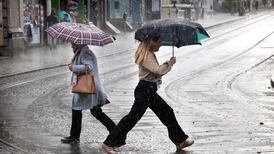MANY of those who gathered in the Round Hall of the Four Courts yesterday morning to see the arrival of Mr Brendan O'Donnell did not at first recognise the accused man when he entered the building.
Handcuffed to one of three escorting prison officers, Mr O'Donnell was brought into the hall just before 10.30 a.m. His hair was cut short, his moustache was trimmed and he appeared to have gained some weight since he was charged in July 1994 with the murder of a priest, a mother and her child.
Court No 2 had been filling up since well before 10 a.m. It was packed with sightseers, relatives of the deceased and people clutching their green jury summons papers by the time Mr O'Donnell was brought in.
At first the prison officers tried to take him through the main door but, seeing the crush at, the back of the court, they directed him through a side door. As Mr O'Donnell sat down, his handcuff was unlocked. A prison officer and a garda sat down to his left, with two more officers and another garda to his right.
Mr Justice Lavan explained the rules of jury duty to those summoned for service and that there were two juries to be selected - one for the trial of Mr O'Donnell and the other for a rape trial to be held in another court.
It was close to 11 a.m. before Mr O'Donnell stood and the court registrar began to read the charges against him. To every charge he replied "not guilty". Jury selection began and once prosecution and defence lawyers' had challenged some potential jurors a jury of six men and six women emerged.
The court adjourned briefly so it could retire to elect a foreman and Mr O'Donnell was escorted to the men's toilets downstairs so, he could smoke a cigarette.
When the trial resumed, Mr Kevin Haugh SC opened the prosecution's case with a low key summary of Imelda Riney's life and the events of the days and hours leading to the three deaths. But he had the attention of everyone in court when he suddenly said she was "shot through the left eye socket" and her three year old son Liam was shot through the left side of the head, as was Father Joseph Walsh. A relative of Father Walsh in the courtroom began to weep quietly.
At 12.40 p.m. a garda from the force's mapping section began to explain how he compiled the series of maps which would be used in the case. His evidence continued after lunch with lawyers, the judge and jurors constantly folding and unfolding their books of six maps and two floor plans as they sought to identify the locations of the alleged crimes.
He was followed by a Garda photographer who outlined how he took the photographs being entered in evidence. The jury was given copies of the photographs, including those of the bodies of Ms Riney, her son and Father Walsh, taken as they lay on the ground.
Throughout, Mr O'Donnell remained expressionless, although occasionally he drummed the fingers of his right hand lightly on the rail before him or moved his lower jaw so that his cheek muscles twitched.
Court was adjourned at 4 p.m. and the room quickly emptied. Some of the victims' relatives stayed in the hall to discuss the case briefly. With them was the Bishop of Clonfert, Dr John Kirby, who said he had come to offer support. Among the last leave the courtroom were Mr O'Donnell and his escort.
He had stayed to talk to Mr Garret Sheehan, his solicitor, and the defending senior counsel, Mr Patrick MacEntee. He shook hands with Mr MacEntee before being handcuffed and led away.







